R-Phase Transformation Evolution in NiTi SMA Wires Studied via the Internal Friction Technique
Abstract
:1. Introduction
2. Materials and Methods
2.1. Materials and Heat-Treatment
2.2. Tensile Properties Test and Hysteresis Loop Test
2.3. X-ray Diffraction
2.4. TEM Characterization
2.5. Internal Friction
3. Results and Discussion
3.1. Tensile Properties
3.2. Pseudoelasticity Properties and Specific Damping Capacity
3.3. X-ray Diffraction
3.4. TEM Result
3.5. Internal Friction
4. Conclusions
- (1)
- Within the heat treatment window of 400 to 450 °C, a holding period of less than one hour followed by quenching yields NiTi nano-crystalline alloys incorporating a nanoscale R phase. TEM results confirmed that this process avoids the formation of nanoprecipitates like Ni4Ti3, thereby preserving a sufficient Ni content in the NiTi matrix.
- (2)
- The appearance of the R phase is attributed to an unevenly distributed stress field, which is different from the traditionally mechanism involving nanoprecipitates by mid-temperature aging.
- (3)
- Utilizing the internal friction technique, the dynamic splitting of a single R phase into two distinct R-phase variants was observed, indicating Ni segregation within the B2 matrix. These two R-phase variants partition the B2 austenite phase into multiple microdomains with varying Ni concentrations, with the enrichment and depletion of Ni in these microdomains driving this observed dynamic phenomenon.
Supplementary Materials
Author Contributions
Funding
Data Availability Statement
Conflicts of Interest
References
- Khalili, V.; Naji, H. Developing a Mechanochemical Surface Pretreatment to Increase the Adhesion Strength of Hydroxyapatite Electrophoretic Coating on the NiTi Alloy as a Bone Implant. Surf. Coat. Technol. 2020, 397, 125985. [Google Scholar] [CrossRef]
- Zhu, S.L.; Yang, X.J.; Chen, M.F.; Li, C.Y.; Cui, Z.D. Effect of Porous NiTi Alloy on Bone Formation: A Comparative Investigation with Bulk NiTi Alloy for 15 Weeks in Vivo. Mater. Sci. Eng. C 2008, 28, 1271–1275. [Google Scholar] [CrossRef]
- Wu, G.; Li, L.; Sun, M.; Wang, Y.; Luo, F.; Zhang, Q.; Liu, R.; Chen, Z.; Yao, J. Microstructural Evolution and Biological Properties of PEO Coating on SLM-Prepared NiTi Alloy. Surf. Coat. Technol. 2023, 452, 129065. [Google Scholar] [CrossRef]
- Patel, S.K.; Behera, B.; Swain, B.; Roshan, R.; Sahoo, D.; Behera, A. A Review on NiTi Alloys for Biomedical Applications and Their Biocompatibility. Mater. Today Proc. 2020, 33, 5548–5551. [Google Scholar] [CrossRef]
- Hartl, D.J.; Lagoudas, D.C. Aerospace Applications of Shape Memory Alloys. Proc. Inst. Mech. Eng. Part G J. Aerosp. Eng. 2007, 221, 535–552. [Google Scholar] [CrossRef]
- Saburi, T.; Nenno, S.; Fukuda, T. Crystal Structure and Morphology of the Metastable X Phase in Shape Memory Ti-Ni Alloys. J. Common Met. 1986, 125, 157–166. [Google Scholar] [CrossRef]
- Waitz, T.; Kazykhanov, V.; Karnthaler, H.P. Martensitic Phase Transformations in Nanocrystalline NiTi Studied by TEM. Acta Mater. 2004, 52, 137–147. [Google Scholar] [CrossRef]
- McCormick, P.G.; Liu, Y. Thermodynamic Analysis of the Martensitic Transformation in NiTi—II. Effect of Transformation Cycling. Acta Metall. Mater. 1994, 42, 2407–2413. [Google Scholar] [CrossRef]
- Wang, X.B.; Verlinden, B.; Van Humbeeck, J. R-Phase Transformation in NiTi Alloys. Mater. Sci. Technol. 2014, 30, 1517–1529. [Google Scholar] [CrossRef]
- Tirry, W.; Schryvers, D. Linking a Completely Three-Dimensional Nanostrain to a Structural Transformation Eigenstrain. Nat. Mater. 2009, 8, 752–757. [Google Scholar] [CrossRef]
- Khalil-Allafi, J.; Dlouhy, A.; Eggeler, G. Ni4Ti3-Precipitation during Aging of NiTi Shape Memory Alloys and Its Influence on Martensitic Phase Transformations. Acta Mater. 2002, 50, 4255–4274. [Google Scholar] [CrossRef]
- Tirry, W.; Schryvers, D. Quantitative Determination of Strain Fields around Ni4Ti3 Precipitates in NiTi. Acta Mater. 2005, 53, 1041–1049. [Google Scholar] [CrossRef]
- Song, Y.; Jin, M.; Han, X.; Wang, X.; Chen, P.; Jin, X. Microstructural Origin of Ultrahigh Damping Capacity in Ni50.8Ti49.2 Alloy Containing Nanodomains Induced by Insufficient Annealing and Low-Temperature Aging. Acta Mater. 2021, 205, 116541. [Google Scholar] [CrossRef]
- Huo, X.; Chen, P.; Lahkar, S.; Jin, M.; Han, X.; Song, Y.; Wang, X. Occurrence of the R-Phase with Increased Stability Induced by Low Temperature Precipitate-Free Aging in a Ni50.9Ti49.1 Alloy. Acta Mater. 2022, 227, 117688. [Google Scholar] [CrossRef]
- Bojda, O.; Eggeler, G.; Dlouhý, A. Precipitation of Ni4Ti3-Variants in a Polycrystalline Ni-Rich NiTi Shape Memory Alloy. Scr. Mater. 2005, 53, 99–104. [Google Scholar] [CrossRef]
- Jiang, S.; Zhang, Y.; Zhao, Y.; Liu, S.; Hu, L.; Zhao, C. Influence of Ni4Ti3 Precipitates on Phase Transformation of NiTi Shape Memory Alloy. Trans. Nonferrous Met. Soc. China 2015, 25, 4063–4071. [Google Scholar] [CrossRef]
- Urbina, C.; De la Flor, S.; Gispert-Guirado, F.; Ferrando, F. Quantitative XRD Analysis of the Evolution of the TiNi Phase Transformation Behaviour in Relation to Thermal Treatments. Intermetallics 2010, 18, 1632–1641. [Google Scholar] [CrossRef]
- Héraud, L.; Castany, P.; Ijaz, M.F.; Gordin, D.-M.; Gloriant, T. Large-Strain Functional Fatigue Properties of Superelastic Metastable β Titanium and NiTi Alloys: A Comparative Study. J. Alloys Compd. 2023, 953, 170170. [Google Scholar] [CrossRef]
- Prokoshkin, S.D.; Brailovski, V.; Korotitskiy, A.V.; Inaekyan, K.E.; Glezer, A.M. Specific Features of the Formation of the Microstructure of Titanium Nickelide upon Thermomechanical Treatment Including Cold Plastic Deformation to Degrees from Moderate to Severe. Phys. Met. Metallogr. 2010, 110, 289–303. [Google Scholar] [CrossRef]
- Kuranova, N.N.; Gunderov, D.V.; Uksusnikov, A.N.; Luk’yanov, A.V.; Yurchenko, L.I.; Prokof’ev, E.A.; Pushin, V.G.; Valiev, R.Z. Effect of Heat Treatment on the Structural and Phase Transformations and Mechanical Properties of TiNi Alloy Subjected to Severe Plastic Deformation by Torsion. Phys. Met. Metallogr. 2009, 108, 556–568. [Google Scholar] [CrossRef]
- Liang, X.; Xiao, F.; Chen, H.; Li, Z.; Jin, X.; Fukuda, T. Growth of B2 Parent Phase Grain Assisted by Martensitic Transformation in a Nanocrystalline Ti-50.8Ni (at.%) Shape Memory Alloy. Scr. Mater. 2019, 159, 37–40. [Google Scholar] [CrossRef]
- Jin, M.; Song, Y.; Wang, X.; Chen, P.; Pang, G.; Jin, X. Ultrahigh Damping Capacity Achieved by Modulating R Phase in Ti49.2Ni50.8 Shape Memory Alloy Wires. Scr. Mater. 2020, 183, 102–106. [Google Scholar] [CrossRef]
- Lin, H.C.; Wu, S.K.; Chou, T.S. Aging Effect on the Low Temperature Internal Friction Relaxation Peak in a Ti49Ni51 Alloy. J. Alloys Compd. 2003, 355, 90–96. [Google Scholar] [CrossRef]
- Frenzel, J.; George, E.P.; Dlouhy, A.; Somsen, C.; Wagner, M.F.-X.; Eggeler, G. Influence of Ni on Martensitic Phase Transformations in NiTi Shape Memory Alloys. Acta Mater. 2010, 58, 3444–3458. [Google Scholar] [CrossRef]
- Zhu, J.; Wu, H.-H.; Wu, Y.; Wang, H.; Zhang, T.; Xiao, H.; Wang, Y.; Shi, S.-Q. Influence of Ni4Ti3 Precipitation on Martensitic Transformations in NiTi Shape Memory Alloy: R Phase Transformation. Acta Mater. 2021, 207, 116665. [Google Scholar] [CrossRef]
- Fukuda, T.; Saburi, T.; Doi, K.; Nenno, S. Nucleation and Self-Accommodation of the R-Phase in Ti–Ni Alloys. Mater. Trans. JIM 1992, 33, 271–277. [Google Scholar] [CrossRef]
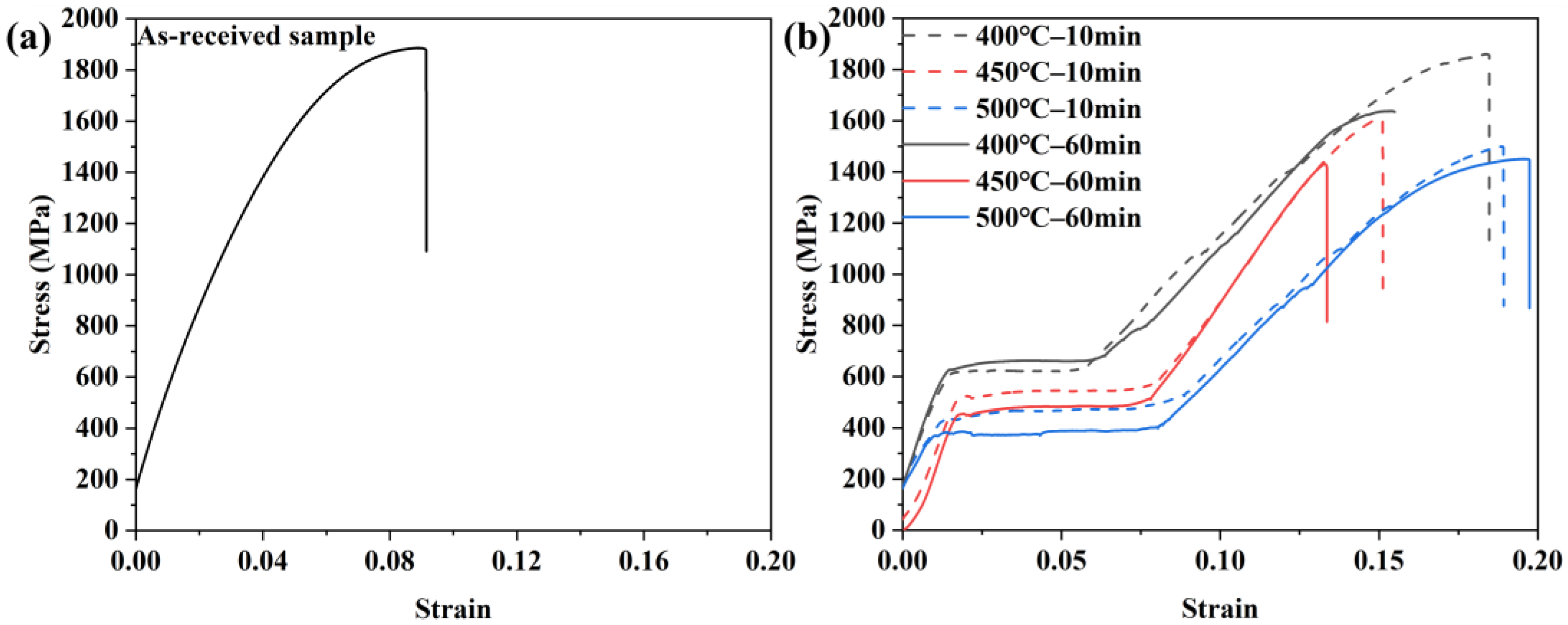

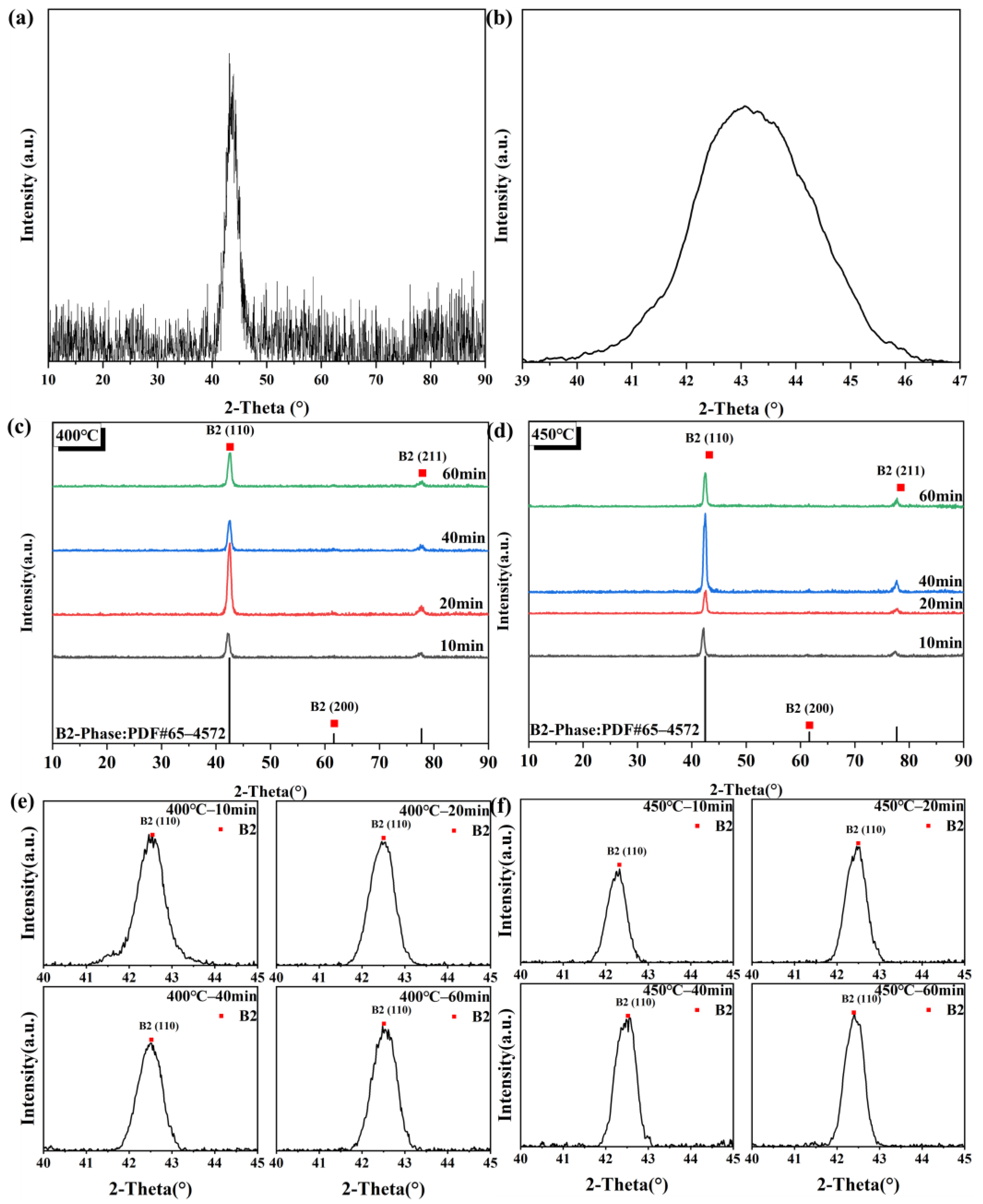
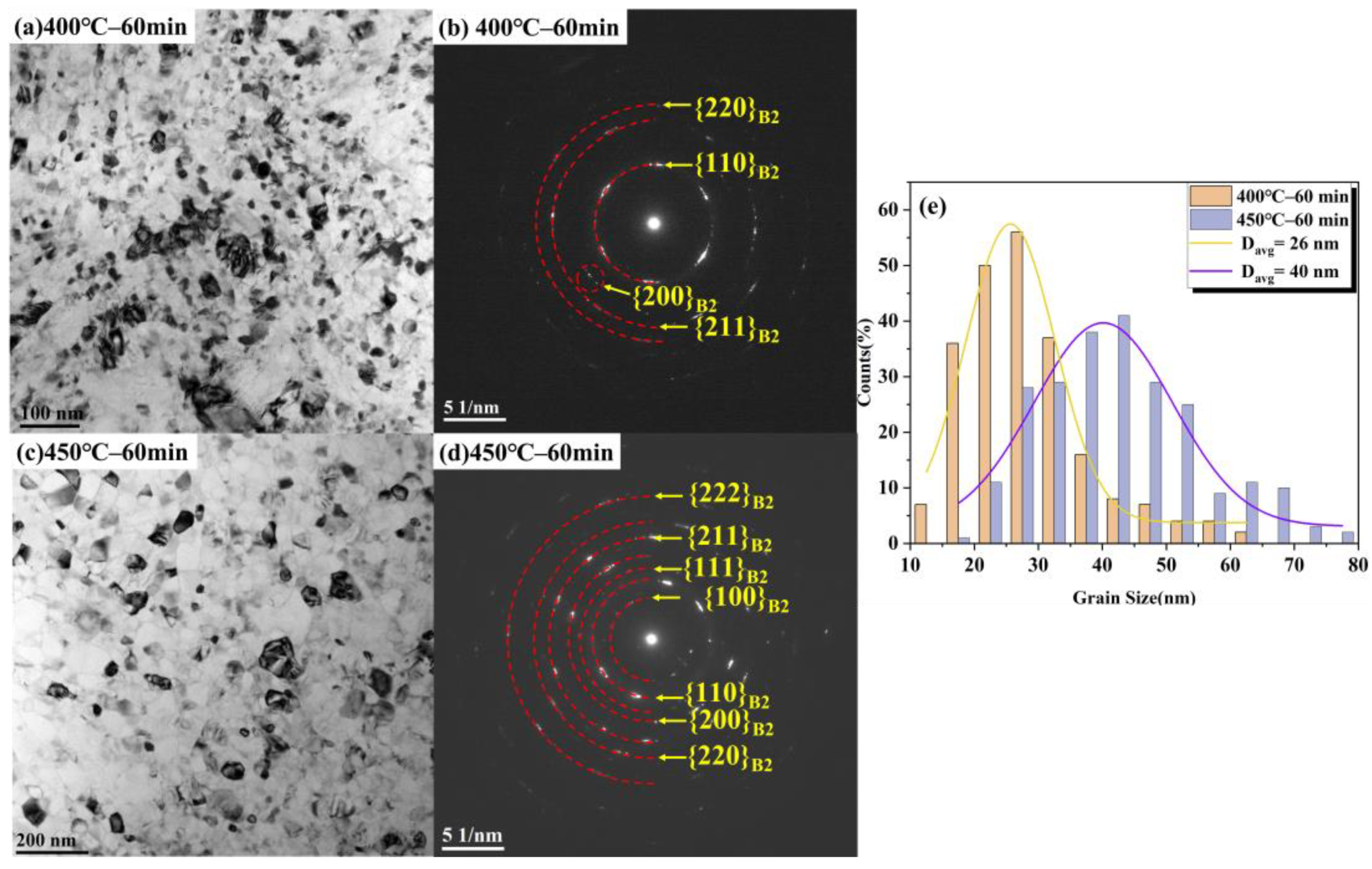
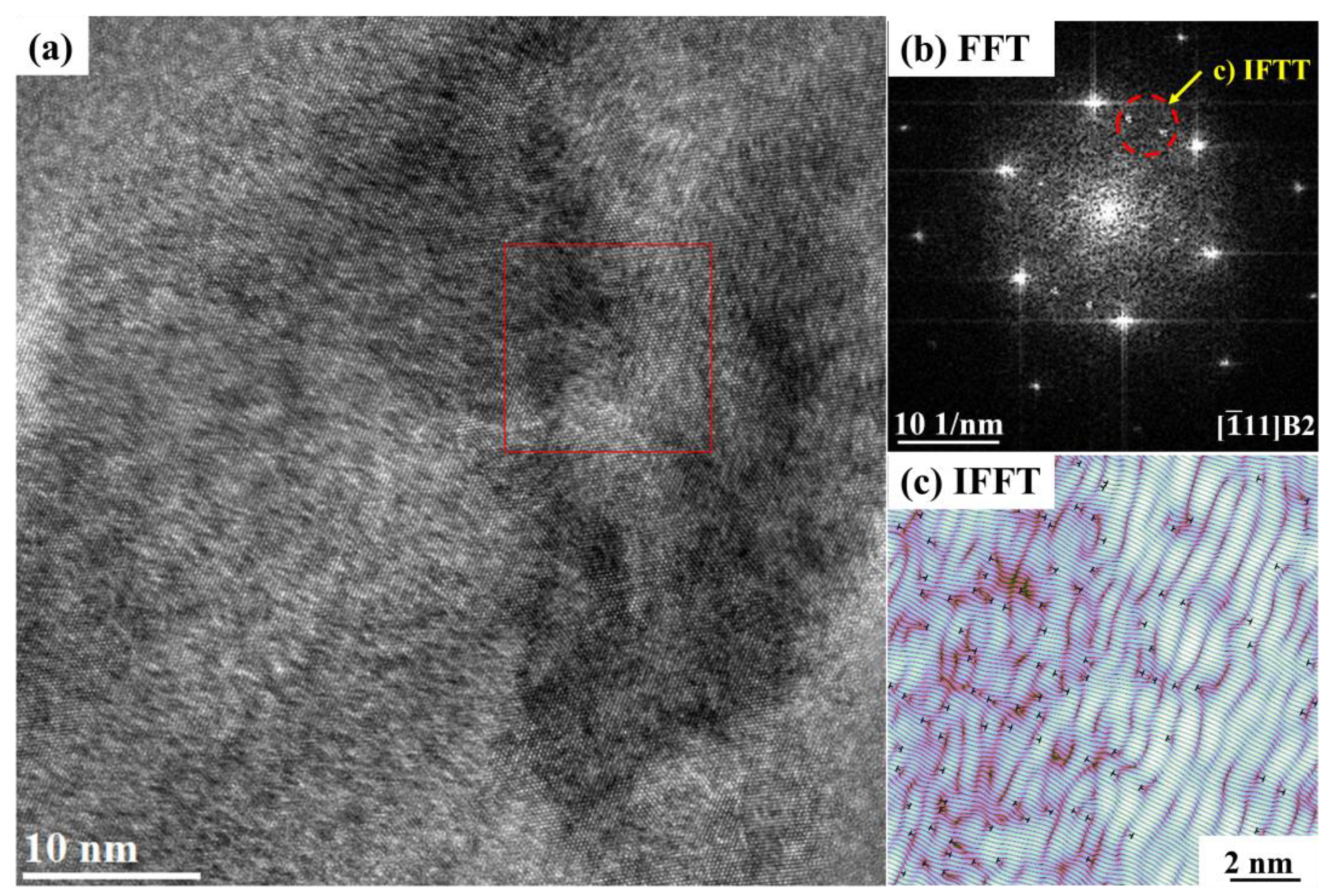
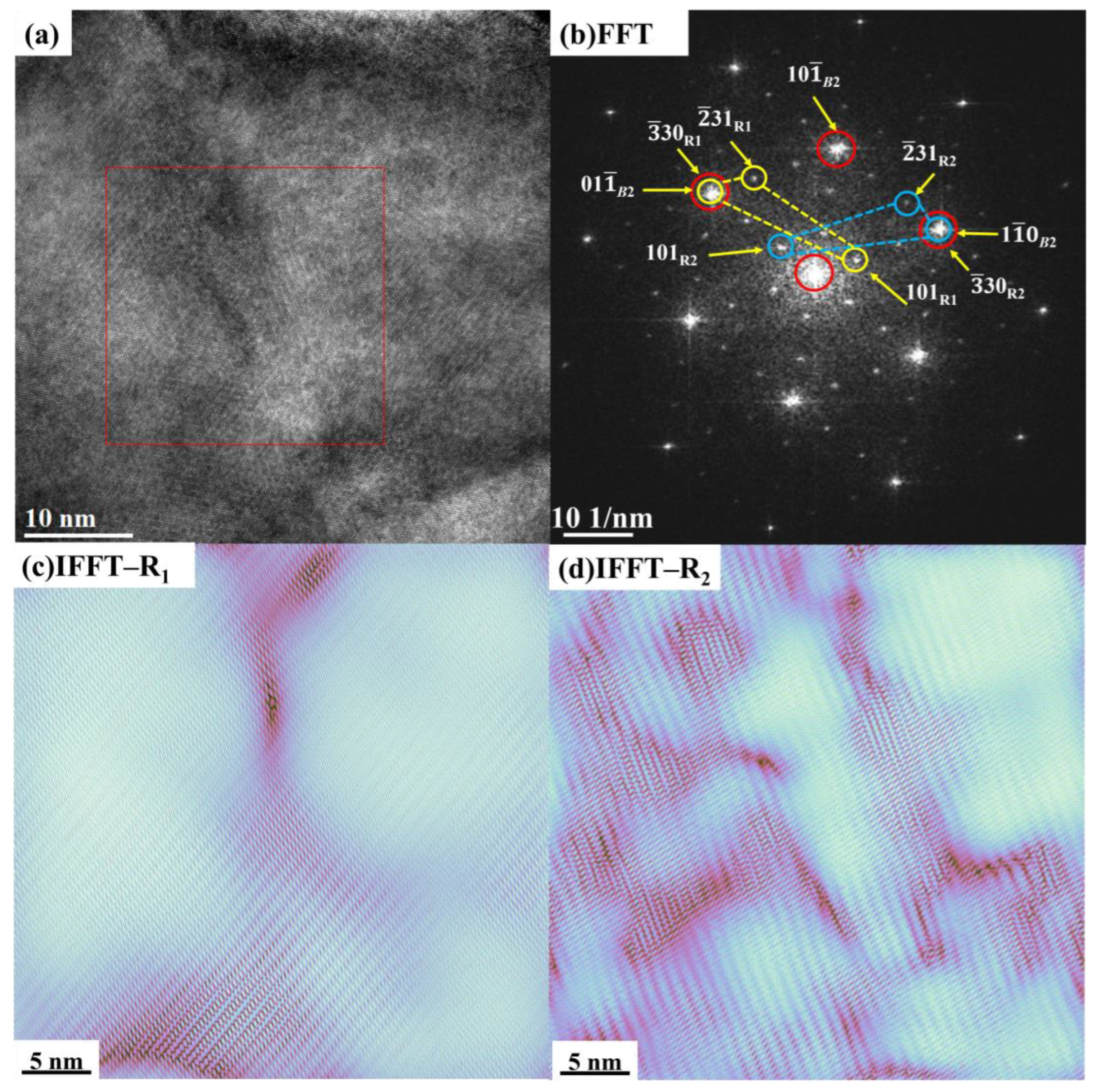
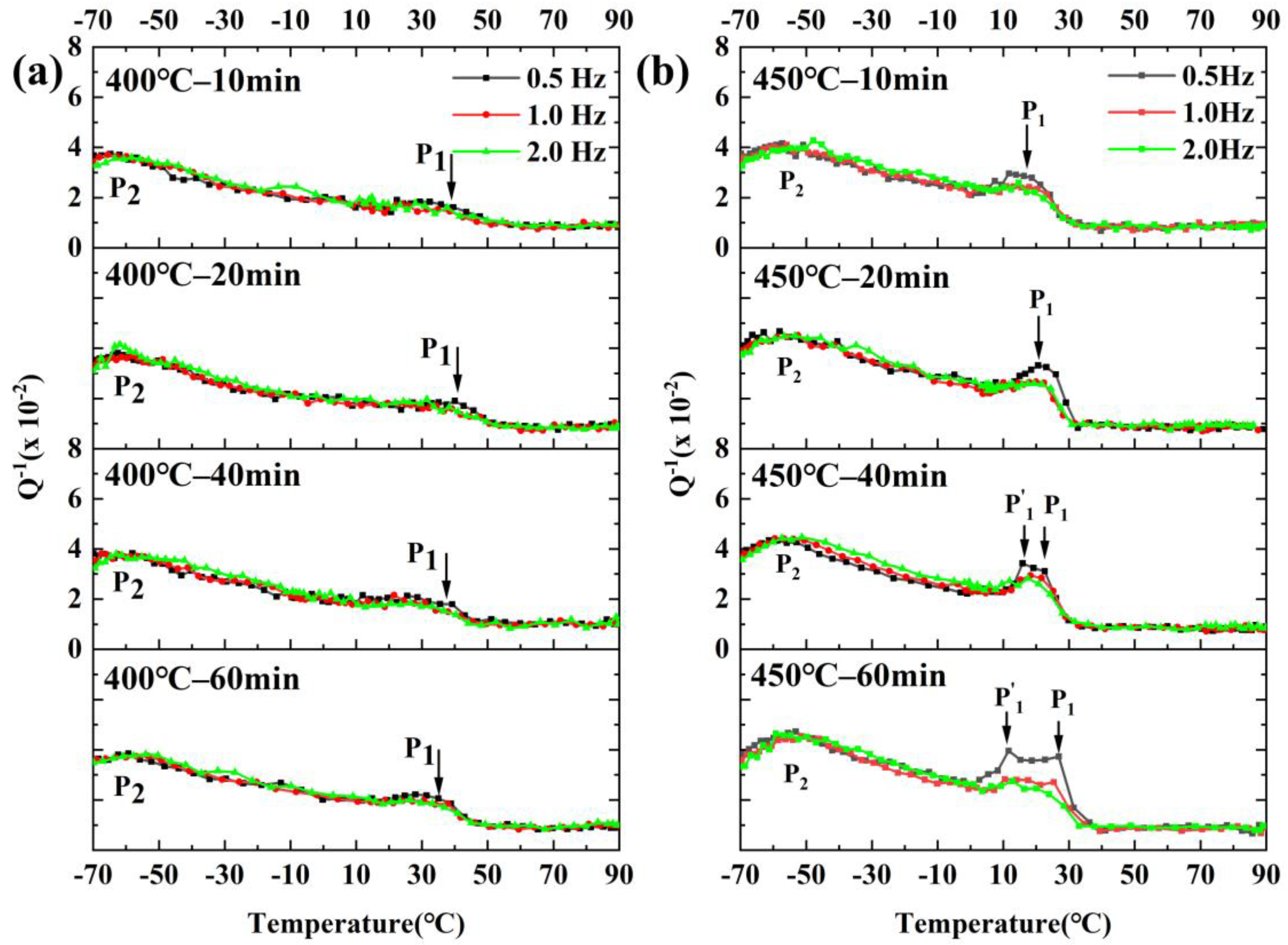
| Samples | 2θ (°) | FWHM (°) |
|---|---|---|
| 400 °C–10 min | 42.508 | 0.741 |
| 400 °C–20 min | 42.470 | 0.661 |
| 400 °C–40 min | 42.486 | 0.652 |
| 400 °C–60 min | 42.525 | 0.646 |
| 450 °C–10 min | 42.260 | 0.516 |
| 450 °C–20 min | 42.485 | 0.491 |
| 450 °C–40 min | 42.603 | 0.347 |
| 450 °C–60 min | 42.529 | 0.360 |
| As-received samples | 43.227 | 2.518 |
Disclaimer/Publisher’s Note: The statements, opinions and data contained in all publications are solely those of the individual author(s) and contributor(s) and not of MDPI and/or the editor(s). MDPI and/or the editor(s) disclaim responsibility for any injury to people or property resulting from any ideas, methods, instructions or products referred to in the content. |
© 2024 by the authors. Licensee MDPI, Basel, Switzerland. This article is an open access article distributed under the terms and conditions of the Creative Commons Attribution (CC BY) license (https://creativecommons.org/licenses/by/4.0/).
Share and Cite
Xu, Y.; Chen, J.; Wang, X.; Sun, M.; Wang, X.; Jiang, W. R-Phase Transformation Evolution in NiTi SMA Wires Studied via the Internal Friction Technique. Crystals 2024, 14, 476. https://doi.org/10.3390/cryst14050476
Xu Y, Chen J, Wang X, Sun M, Wang X, Jiang W. R-Phase Transformation Evolution in NiTi SMA Wires Studied via the Internal Friction Technique. Crystals. 2024; 14(5):476. https://doi.org/10.3390/cryst14050476
Chicago/Turabian StyleXu, Yuhao, Junlan Chen, Xinggang Wang, Meng Sun, Xianping Wang, and Weibin Jiang. 2024. "R-Phase Transformation Evolution in NiTi SMA Wires Studied via the Internal Friction Technique" Crystals 14, no. 5: 476. https://doi.org/10.3390/cryst14050476
APA StyleXu, Y., Chen, J., Wang, X., Sun, M., Wang, X., & Jiang, W. (2024). R-Phase Transformation Evolution in NiTi SMA Wires Studied via the Internal Friction Technique. Crystals, 14(5), 476. https://doi.org/10.3390/cryst14050476







